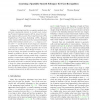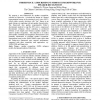94 search results - page 5 / 19 » Nonparametric Subspace Analysis for Face Recognition |
CVPR
2007
IEEE
15 years 26 days ago
2007
IEEE
Subspace learning based face recognition methods have attracted considerable interests in recently years, including Principal Component Analysis (PCA), Linear Discriminant Analysi...
ICPR
2004
IEEE
14 years 12 months ago
2004
IEEE
In the past decade or so, subspace methods have been largely used in face recognition ? generally with quite success. Subspace approaches, however, generally assume the training d...
ICASSP
2010
IEEE
13 years 11 months ago
2010
IEEE
We propose a new framework for speaker recognition, referred as Fishervoice. It includes the design of a feature representation known as the structured score vector (SSV), which r...
CVPR
2009
IEEE
15 years 6 months ago
2009
IEEE
The variations of pose lead to significant performance
decline in face recognition systems, which is a bottleneck
in face recognition. A key problem is how to measure the
simila...
PCM
2007
Springer
14 years 5 months ago
2007
Springer
The two-dimensional Principal Component Analysis (2DPCA) is a robust method in face recognition. Much recent research shows that the 2DPCA is more reliable than the well-known PCA ...



